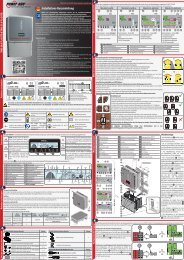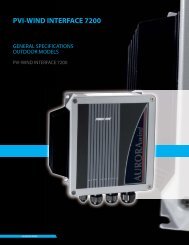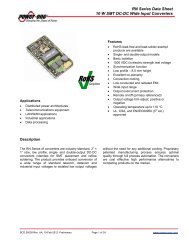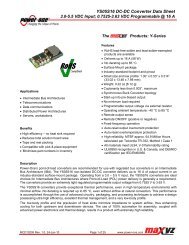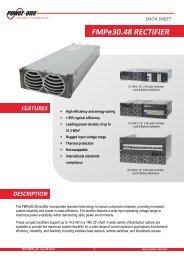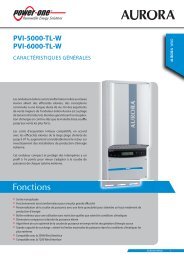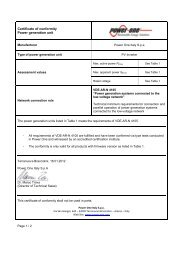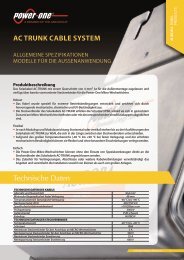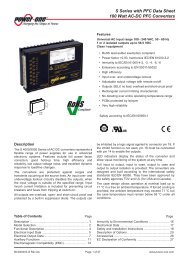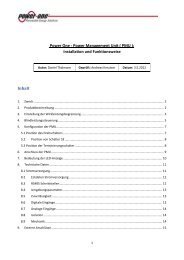YNC12S20 DC-DC Converter Data Sheet - Power-One
YNC12S20 DC-DC Converter Data Sheet - Power-One
YNC12S20 DC-DC Converter Data Sheet - Power-One
You also want an ePaper? Increase the reach of your titles
YUMPU automatically turns print PDFs into web optimized ePapers that Google loves.
<strong>YNC12S20</strong> <strong>DC</strong>-<strong>DC</strong> <strong>Converter</strong> <strong>Data</strong> <strong>Sheet</strong>9.6-14 V<strong>DC</strong> Input; 0.7525-5.5 V<strong>DC</strong> Programmable @ 20 ATheProducts: Y-SeriesApplications Intermediate Bus Architectures Telecommunications <strong>Data</strong> communications Distributed <strong>Power</strong> Architectures Servers, workstationsBenefits High efficiency – no heat sink required Reduces total solution board area Tape and reel packing Compatible with pick & place equipment Minimizes part numbers in inventoryDescriptionFeatures RoHS lead-free solder and lead-solder-exemptedproducts are available Delivers up to 20 A (100 W) Extended input range 9.6 V – 14 V High efficiency (0.94 at 5 V output) Surface-mount package Industry-standard footprint and pinout Small size and low profile: 1.30” x 0.53” x 0.314”(33.02 x 13.46 x 7.98 mm) Weight: 0.22 oz [6.12 g] Coplanarity less than 0.003”, maximum Synchronous Buck <strong>Converter</strong> topology Source and sink capable Start-up into pre-biased output No minimum load required Programmable output voltage via external resistor Operating ambient temperature: -40 °C to 85 °C Remote output sense Remote ON/OFF (Positive or Negative) Fixed-frequency operation Auto-reset output overcurrent protection Auto-reset overtemperature protection High reliability, MTBF = TBD Million Hours All materials meet UL94, V-0 flammability rating UL 60950-1 recognition in the US & Canada, and TUVSUD certification per IEC/EN 60950-1<strong>Power</strong>-<strong>One</strong>’s point-of-load converters are recommended for use with regulated bus converters in anIntermediate Bus Architecture (IBA). The <strong>YNC12S20</strong> non-isolated <strong>DC</strong>-<strong>DC</strong> converter delivers up to 20 A ofoutput current in an industry-standard surface-mount package. Operating from a 9.6 to 14 V<strong>DC</strong> input, the<strong>YNC12S20</strong> converter is an ideal choice for Intermediate Bus Architectures where point-of-load power deliveryis generally a requirement. It provides a resistor-programmable regulated output voltage of 0.7525V to 5.5V.The Y-Series converters provide exceptional thermal performance, even in high temperature environmentswith minimal airflow. This is accomplished through the use of circuit, packaging and processing techniques toachieve ultra-high efficiency, excellent thermal management and a very low body profile.The low body profile and the preclusion of heat sinks minimize impedance to system airflow, thus enhancingcooling for both upstream and downstream devices. The use of 100% automation for assembly, coupled withadvanced power electronics and thermal design, results in a product with extremely high reliability.ZD-02137 Rev. 2.1 21-Jun-10 Page 1 of 28 www.power-one.com
<strong>YNC12S20</strong> <strong>DC</strong>-<strong>DC</strong> <strong>Converter</strong> <strong>Data</strong> <strong>Sheet</strong>9.6-14 V<strong>DC</strong> Input; 0.7525-5.5 V<strong>DC</strong> Programmable @ 20 AElectrical SpecificationsConditions: T A =25ºC, Airflow=200 LFM (1 m/s), Vin=12 V<strong>DC</strong>, Vout = 0.7525 - 5.5V, unless otherwise specified.PARAMETER NOTES MIN TYP MAX UNITSABSOLUTE MAXIMUM RATINGSInput Voltage Continuous -0.3 15 V<strong>DC</strong>Operating Ambient Temperature -40 85 °CStorage Temperature -55 125 °CFEATURE CHARACTERISTICSSwitching Frequency 300 kHzOutput Voltage Programming Range 1 By external resistor, See Trim Table 1 0.7525 5.5 V<strong>DC</strong>Remote Sense Compensation 1 0.5 V<strong>DC</strong>Turn-On Delay TimeFull resistive loadWith Vin = (Module Enabled, then Vin applied) From Vin = Vin(min) to Vo=0.1* Vo(nom) 3 msWith Enable (Vin = Vin(nom) applied, then enabled) From enable to Vo= 0.1*Vo(nom) 3 msRise time From 10% to 90%, full resistive load 4 msON/OFF Control (Positive Logic) 2Module Off -5 0.8 V<strong>DC</strong>Module On 2.4 V IN V<strong>DC</strong>ON/OFF Control (Negative Logic) 2Note:Module Off 2.4 V IN V<strong>DC</strong>Module On -5 0.8 V<strong>DC</strong>1. The output voltage should not exceed 5.5V (taking into account both the programming and remote sense compensation).2. <strong>Converter</strong> is on if ON/OFF pin is left open.3. Note that start-up time is the sum of turn-on delay time and rise time.ZD-02137 Rev. 2.1 21-Jun-10 Page 2 of 28 www.power-one.com
<strong>YNC12S20</strong> <strong>DC</strong>-<strong>DC</strong> <strong>Converter</strong> <strong>Data</strong> <strong>Sheet</strong>9.6-14 V<strong>DC</strong> Input; 0.7525-5.5 V<strong>DC</strong> Programmable @ 20 AElectrical Specifications (continued)Conditions: T A =25ºC, Airflow=200 LFM (1 m/s), Vin=12 V<strong>DC</strong>, Vout = 0.7525 - 5.5V, unless otherwise specified.PARAMETER NOTES MIN TYP MAX UNITSINPUT CHARACTERISTICSOperating Input Voltage Range 9.6 12 14 V<strong>DC</strong>Input Under Voltage LockoutTurn-on Threshold 9 V<strong>DC</strong>Turn-off Threshold 8.5 V<strong>DC</strong>Maximum Input Current20 A<strong>DC</strong> Out @ 9.6 V<strong>DC</strong> InV OUT = 5.0 V<strong>DC</strong> 11.1 A<strong>DC</strong>V OUT = 3.3 V<strong>DC</strong> 7.6 A<strong>DC</strong>V OUT = 2.5 V<strong>DC</strong> 5.9 A<strong>DC</strong>V OUT = 2.0 V<strong>DC</strong> 4.8 A<strong>DC</strong>V OUT = 1.8 V<strong>DC</strong> 4.4 A<strong>DC</strong>V OUT = 1.5 V<strong>DC</strong> 3.8 A<strong>DC</strong>V OUT = 1.2 V<strong>DC</strong> 3.1 A<strong>DC</strong>V OUT = 1.0 V<strong>DC</strong> 2.7 A<strong>DC</strong>V OUT = 0.7525 V<strong>DC</strong> 2.2 A<strong>DC</strong>Input Stand-by Current (Module disabled) 5 mAInput No Load Current (Module enabled) V OUT = 5.0 V<strong>DC</strong> 80 mAV OUT = 3.3 V<strong>DC</strong> 62 mAV OUT = 2.5 V<strong>DC</strong> 52 mAV OUT = 2.0 V<strong>DC</strong> 47 mAV OUT = 1.8 V<strong>DC</strong> 45 mAV OUT = 1.5 V<strong>DC</strong> 43 mAV OUT = 1.2 V<strong>DC</strong> 41 mAV OUT = 1.0 V<strong>DC</strong> 39 mAV OUT = 0.7525 V<strong>DC</strong> 35 mAInput Reflected-Ripple Current - i s See Fig. F for setup. (BW=20 MHz) TBD mA P-PInput Voltage Ripple Rejection 120 Hz 72 dBZD-02137 Rev. 2.1 21-Jun-10 Page 3 of 28 www.power-one.com
<strong>YNC12S20</strong> <strong>DC</strong>-<strong>DC</strong> <strong>Converter</strong> <strong>Data</strong> <strong>Sheet</strong>9.6-14 V<strong>DC</strong> Input; 0.7525-5.5 V<strong>DC</strong> Programmable @ 20 AElectrical Specifications (continued)Conditions: T A =25 ºC, Airflow=200 LFM (1 m/s), Vin=12 V<strong>DC</strong>, Vout = 0.7525 – 5.5 V, unless otherwise specified.PARAMETER NOTES MIN TYP MAX UNITSOUTPUT CHARACTERISTICSOutput Voltage Set Point (no load) -1.5 Vout +1.5 %VoutOutput RegulationOver Line Full resistive load 2 mVOver Load From no load to full load 10 mVOutput Voltage Range(Over all operating input voltage, resistive loadand temperature conditions until end of life )-2.5 +2.5 %VoutOutput Ripple and Noise - 20MHz bandwidth (Fig. F)Over line, load and temperaturePeak-to-Peak V OUT = 0.7525 V<strong>DC</strong> 10 15 mV P-PPeak-to-Peak V OUT = 5.0 V<strong>DC</strong> 35 50 mV P-PExternal Load CapacitancePlus full load (resistive)Min ESR > 1mΩ 1,000 μFMin ESR > 10 mΩ 5,000 μFOutput Current Range 0 20 AOutput Current Limit Inception (I OUT ) 26 AOutput Short-Circuit Current , RMS Value Short=10 mΩ, continuous 6 ADYNAMIC RESPONSELoad current change from 10A – 20A, di/dt = 5 A/μS Co = 100μF ceramic + 470 μF POS 140 mVSettling Time (V OUT < 10% peak deviation) 45 µsUnloading current change 20A – 10A, di/dt = -5 A/μS Co = 100 μF ceramic + 470 μF POS 140 mVSettling Time (V OUT < 10% peak deviation) 45 µsEFFICIENCYFull load (20A)V OUT = 5.0 V<strong>DC</strong> 94 %V OUT = 3.3 V<strong>DC</strong> 91 %V OUT = 2.5 V<strong>DC</strong> 89 %V OUT = 2.0 V<strong>DC</strong> 87 %V OUT = 1.8 V<strong>DC</strong> 86 %V OUT = 1.5 V<strong>DC</strong> 84 %V OUT = 1.2 V<strong>DC</strong> 81.5 %V OUT = 1.0 V<strong>DC</strong> 78 %V OUT = 0.7525 V<strong>DC</strong> 73.5 %ZD-02137 Rev. 2.1 21-Jun-10 Page 4 of 28 www.power-one.com
<strong>YNC12S20</strong> <strong>DC</strong>-<strong>DC</strong> <strong>Converter</strong> <strong>Data</strong> <strong>Sheet</strong>9.6-14 V<strong>DC</strong> Input; 0.7525-5.5 V<strong>DC</strong> Programmable @ 20 AOperationInput and Output ImpedanceThe Y-Series converter should be connected via alow impedance to the <strong>DC</strong> power source. In manyapplications, the inductance associated with thedistribution from the power source to the input ofthe converter can affect the stability of theconverter. It is recommended to use decouplingcapacitors in order to ensure stability of theconverter and reduce input ripple voltage. Theconverter has an internal input capacitance of 40μF with very low ESR (ceramic capacitors).In a typical application, low - ESR tantalum orPOS capacitors will be sufficient to provideadequate ripple voltage filtering at the input of theconverter. However, very low ESR ceramiccapacitors 47μF-100 μF are recommended at theinput of the converter in order to minimize theinput ripple voltage. They should be placed asclose as possible to the input pins of the converter.<strong>YNC12S20</strong> has been designed for stableoperation with or without external capacitance.Low ESR ceramic capacitors placed as close aspossible to the load (Min 47 μF) are recommendedfor improved transient performance and loweroutput voltage ripple.It is important to keep low resistance and lowinductance PCB traces for connecting load to theoutput pins of the converter in order to maintaingood load regulation.ON/OFF (Pin 1)The ON/OFF pin is used to turn the powerconverter on or off remotely via a system signal.There are two remote control options available,positive logic (standard option) and negative logic,and both are referenced to GND. Typicalconnections are shown in Fig. A.The positive logic version turns the converter onwhen the ON/OFF pin is at a logic high or leftopen, and turns the converter off when at a logiclow or shorted to GND.VinCONTROLINPUTR*VinON/OFFGNDR* is for negative logic option onlyTMNex -c Series<strong>Converter</strong>(Top View)SENSEVoutTRIMFig. A: Circuit configuration for ON/OFF function.The negative logic version turns the converter onwhen the ON/OFF pin is at logic low or left open,and turns the converter off when the ON/OFF pinis at a logic high or connected to Vin.ON/OFF pin is internally pulled-up to Vin for apositive logic version, and pulled-down for anegative logic version. A TTL or CMOS logic gate,open collector (open drain) transistor can be usedto drive ON/OFF pin. When using open collector(open drain) transistor with a negative logic option,add a pull-up resistor (R*) of 75 kΩ to Vin asshown in Fig. A; This device must be capable of:- sinking up to 0.2 mA at a low level voltage of 0.8 V- sourcing up to 0.25 mA at a high logic level of2.3V – 5V- sourcing up to 0.75 mA when connected to Vin.Remote Sense (Pin 2)The remote sense feature of the convertercompensates for voltage drops occurring onlybetween Vout pin (Pin 4) of the converter and theload. The SENSE (Pin 2) pin should be connectedat the load or at the point where regulation isrequired (see Fig. B). There is no sense feature onthe output GND return pin, where a solid groundplane is recommended to provide low voltagedrop.If remote sensing is not required, the SENSE pinmust be connected to the Vout pin (Pin 4) toensure the converter will regulate at the specifiedoutput voltage. If these connections are not made,the converter will deliver an output voltage that isslightly higher than the specified value.RloadZD-02137 Rev. 2.1 21-Jun-10 Page 5 of 28 www.power-one.com
<strong>YNC12S20</strong> <strong>DC</strong>-<strong>DC</strong> <strong>Converter</strong> <strong>Data</strong> <strong>Sheet</strong>9.6-14 V<strong>DC</strong> Input; 0.7525-5.5 V<strong>DC</strong> Programmable @ 20 AVinTMNex -c Series<strong>Converter</strong>SENSEVinTMNex -c Series<strong>Converter</strong>SENSEVinON/OFF(Top View)VoutRwVinON/OFF(Top View)VoutGNDTRIMRloadGNDTRIMRloadR TRIMRwFig. B: Remote sense circuit configuration.Because the sense lead carries minimal current,large traces on the end-user board are notrequired. However, sense traces should belocated close to a ground plane to minimizesystem noise and ensure optimum performance.When utilizing the remote sense feature, caremust be taken not to exceed the maximumallowable output power capability of the converter,equal to the product of the nominal output voltageand the allowable output current for the givenconditions.When using remote sense, the output voltage atthe converter can be increased up to 0.5V abovethe nominal rating in order to maintain the requiredvoltage across the load. Therefore, the designermust, if necessary, decrease the maximum current(originally obtained from the derating curves) bythe same percentage to ensure the converter’sactual output power remains at or below themaximum allowable output power.Output Voltage Programming (Pin 3)The output voltage can be programmed from0.7525V to 5.5V by connecting an external resistorbetween TRIM pin (Pin 3) and GND pin (Pin 5);see Fig. C.A trim resistor, R TRIM , for a desired output voltagecan be calculated using the following equation:10.5RTRIM 1[k](VO-REQ- 0.7525)where,RTRIM Required value of trim resistor [k]VOREQ Desired (trimmed) output voltage [V]Fig. C: Configuration for programming output voltage.Note that the tolerance of a trim resistor directlyaffects the output voltage tolerance. It isrecommended to use standard 1% or 0.5%resistors; for tighter tolerance, two resistors inparallel are recommended rather than onestandard value from Table 1.The ground pin of the trim resistor should beconnected directly to the converter GND pin (Pin5) with no voltage drop in between. Table 1provides the trim resistor values for popular outputvoltages.Table 1: Trim Resistor ValueThe ClosestV 0-REG [V] R TRIM [kΩ]Standard Value [kΩ]0.7525 open1.0 41.2 41.21.2 22.46 22.61.5 13.0 13.01.8 9.0 9.092.0 7.4 7.322.5 5.0 4.993.3 3.12 3.095.0 1.47 1.475.5 1.21 1.21The output voltage can be also programmed byexternal voltage source. To make trimming lesssensitive, a series external resistor Rext isrecommended between the TRIM pin and theprogramming voltage source. Control Voltage canbe calculated by the formula:(1REXT)(VO-REQ- 0.7525)VCTRL 0.7 [V]15where,ZD-02137 Rev. 2.1 21-Jun-10 Page 6 of 28 www.power-one.com
<strong>YNC12S20</strong> <strong>DC</strong>-<strong>DC</strong> <strong>Converter</strong> <strong>Data</strong> <strong>Sheet</strong>9.6-14 V<strong>DC</strong> Input; 0.7525-5.5 V<strong>DC</strong> Programmable @ 20 AVCTRL Control voltage [V]REXT External resistor between TRIM pin andvoltage source; the value can be chosendepending on the required output voltage range[k].Control voltages withshown in Table 2.REXT 0 and REXT 15k areTable 2: Control Voltage [V<strong>DC</strong>]V 0-REG [V] V CTRL (R EXT = 0) V CTRL (R EXT = 15k)0.7525 0.700 0.7001.0 0.684 0.4361.2 0.670 0.2231.5 0.650 -0.0971.8 0.630 -0.4172.0 0.617 -0.6312.5 0.584 -1.1643.3 0.530 -2.0175.0 0.417 -3.8315.5 0.384 -4.364Protection FeaturesInput Undervoltage LockoutInput undervoltage lockout is standard with thisconverter. The converter will shut down when theinput voltage drops below a pre-determinedvoltage; it will start automatically when Vin returnsto a specified range.The input voltage must be at least 9.6V (typically9V) for the converter to turn on. Once theconverter has been turned on, it will shut off whenthe input voltage drops below typically 8.5V.Output Overcurrent Protection (OCP)The converter is protected against overcurrent andshort-circuit conditions. Upon sensing an overcurrentcondition (see Fig. D), the converter willenter hiccup mode. Once the overload or shortcircuit condition is removed, Vout will return tonominal value.Fig. D: Output short circuit current (10 A/div)(R LOAD = 10 mOhm) for Vout = 5.0 V Time scale:1 ms/div.; Bottom trace: Zoomed current with timescale 0.1 ms/div.Overtemperature Protection (OTP)The converter will shut down under anovertemperature condition to protect itself fromoverheating caused by operation outside thethermal derating curves, or operation in abnormalconditions such as system fan failure. After theconverter has cooled to a safe operatingtemperature, it will automatically restart.Safety RequirementsThe converter meets North American andInternational safety regulatory requirements perUL60950 and EN60950. The maximum <strong>DC</strong>voltage between any two pins is Vin under alloperating conditions. Therefore, the unit has ELV(extra low voltage) output; it meets SELVrequirements under the condition that all inputvoltages are ELV.The converter is not internally fused. To complywith safety agencies requirements, a recognizedfuse with a maximum rating of 20 Amps must beused in series with the input line.ZD-02137 Rev. 2.1 21-Jun-10 Page 7 of 28 www.power-one.com
<strong>YNC12S20</strong> <strong>DC</strong>-<strong>DC</strong> <strong>Converter</strong> <strong>Data</strong> <strong>Sheet</strong>9.6-14 V<strong>DC</strong> Input; 0.7525-5.5 V<strong>DC</strong> Programmable @ 20 ACharacterizationGeneral InformationThe converter has been characterized for manyoperational aspects, to include thermal derating(maximum load current as a function of ambienttemperature and airflow) for vertical and horizontalmounting, efficiency, start-up and shutdownparameters, output ripple and noise, transientresponse to load step-change, overload, and shortcircuit.The figures are numbered as Fig. x.y, where xindicates the different output voltages, and yassociates with specific plots (y = 1 for the verticalthermal derating, …). For example, Fig. x.1 willrefer to the vertical thermal derating for all theoutput voltages in general.The following pages contain specific plots orwaveforms associated with the converter.Additional comments for specific data are providedbelow.Test ConditionsAll thermal and efficiency data presented weretaken with the converter soldered to a test board,specifically a 0.060” thick printed wiring board(PWB) with four layers. The top and bottom layerswere not metalized. The two inner layers,comprising two-ounce copper, were used toprovide traces for connectivity to the converter.recommends the use of AWG #40 gaugethermocouples to ensure measurement accuracy.Careful routing of the thermocouple leads willfurther minimize measurement error. Refer to Fig.E for optimum measuring thermocouple location.Thermal DeratingLoad current vs. ambient temperature and airflowrates are given in Figs. x.1 for maximumtemperature of 120 °C. Ambient temperature wasvaried between 25 °C and 85 °C, with airflow ratesfrom 30 to 500 LFM (0.15m/s to 2.5 m/s), andvertical converter mounting. The airflow during thetesting is parallel to the short axis of the converter,going from pin 1 and pin 6 to pins 2 – 5.For each set of conditions, the maximum loadcurrent was defined as the lowest of:(i) The output current at which either any MOSFETtemperature did not exceed a maximum specifiedtemperature (120°C) as indicated by thethermographic image, or(ii) The maximum current rating of the converter(20 A)During normal operation, derating curves withmaximum FET temperature less than or equal to120 °C should not be exceeded. Temperature onthe PCB at the thermocouple location shown inFig. E should not exceed 120 °C in order tooperate inside the derating curves.The lack of metalization on the outer layers as wellas the limited thermal connection ensured thatheat transfer from the converter to the PWB wasminimized. This provides a worst-case butconsistent scenario for thermal derating purposes.All measurements requiring airflow were made invertical and horizontal wind tunnel facilities usingInfrared (IR) thermography and thermocouples forthermometry.Ensuring components on the converter do notexceed their ratings is important to maintaininghigh reliability. If one anticipates operating theconverter at or close to the maximum loadsspecified in the derating curves, it is prudent tocheck actual operating temperatures in theapplication. Thermographic imaging is preferable;if this capability is not available, thenthermocouples may be used. <strong>Power</strong>-<strong>One</strong>Fig. E: Location of the thermocouple for thermal testing.EfficiencyFigure x.2 shows the efficiency vs. load currentplot for ambient temperature of 25 ºC, airflow rateof 200 LFM (1 m/s) and input voltages of 9.6 V,12 V, and 14 V.ZD-02137 Rev. 2.1 21-Jun-10 Page 8 of 28 www.power-one.com
<strong>YNC12S20</strong> <strong>DC</strong>-<strong>DC</strong> <strong>Converter</strong> <strong>Data</strong> <strong>Sheet</strong>9.6-14 V<strong>DC</strong> Input; 0.7525-5.5 V<strong>DC</strong> Programmable @ 20 A<strong>Power</strong> DissipationFig. x.3 shows the power dissipation vs. loadcurrent plot for Ta = 25 ºC, airflow rate of 200 LFM(1 m/s) with vertical mounting and input voltagesof 9.6 V, 12 V, and 14 V.Ripple and NoiseThe output voltage ripple waveform is measured atfull rated load current. Note that all output voltagewaveforms are measured across a 1 F ceramiccapacitor.The output voltage ripple and input reflected ripplecurrent waveforms are obtained using the testsetup shown in Fig. F.i S1 HsourceinductanceVsourceC IN4x47FceramiccapacitorTMNex -c Series<strong>DC</strong>/<strong>DC</strong><strong>Converter</strong>1FceramiccapacitorC O100FceramiccapacitorVoutFig. F: Test setup for measuring input reflected ripplecurrents, i s and output voltage ripple.ZD-02137 Rev. 2.1 21-Jun-10 Page 9 of 28 www.power-one.com
<strong>YNC12S20</strong> <strong>DC</strong>-<strong>DC</strong> <strong>Converter</strong> <strong>Data</strong> <strong>Sheet</strong>9.6-14 V<strong>DC</strong> Input; 0.7525-5.5 V<strong>DC</strong> Programmable @ 20 A2520Load Current [Adc]15105500 LFM (2.5 m/s)400 LFM (2.0 m/s)300 LFM (1.5 m/s)200 LFM (1.0 m/s)100 LFM (0.5 m/s)30 LFM (0.15 m/s)020 30 40 50 60 70 80 90Ambient Temperature [°C]Fig. 5.0V.1: Available load current vs. ambient temperatureand airflow rates for Vout = 5.0 V converter mountedvertically with Vin = 12 V, and maximum MOSFETtemperature 120 C.1.00100.958Efficiency0.900.850.8014 V12 V9.6 V<strong>Power</strong> Dissipation [W]64214 V12 V9.6 V0.750 4 8 12 16 20 24Load Current [Adc]Fig. 5.0V.2: Efficiency vs. load current and inputvoltage for Vout = 5.0 V converter mounted verticallywith air flowing at a rate of 200 LFM (1 m/s) and Ta =25 C.00 4 8 12 16 20 24Load Current [Adc]Fig. 5.0V.3: <strong>Power</strong> loss vs. load current and inputvoltage for Vout = 5.0 V converter mounted verticallywith air flowing at a rate of 200 LFM (1 m/s) and Ta =25 C.ZD-02137 Rev. 2.1 21-Jun-10 Page 10 of 28 www.power-one.com
<strong>YNC12S20</strong> <strong>DC</strong>-<strong>DC</strong> <strong>Converter</strong> <strong>Data</strong> <strong>Sheet</strong>9.6-14 V<strong>DC</strong> Input; 0.7525-5.5 V<strong>DC</strong> Programmable @ 20 AFig. 5.0V.4: Turn-on transient for Vout = 5.0 V withapplication of Vin at full rated load current(resistive) and 100 μF external capacitance at Vin =12 V. Top trace: Vin (10 V/div.); Bottom trace:output voltage (1 V/div.); Time scale: 2 ms/div.Fig. 5.0V.5: Output voltage ripple (20 mV/div.) at fullrated load current into a resistive load with externalcapacitance 100 μF ceramic + 1 μF ceramic and Vin =12 V for Vout = 5.0 V. Time scale: 2 μs/div.Fig. 5.0V.6: Output voltage response for Vout = 5.0 Vto positive load current step change from 10 A to 20 Awith slew rate of 5 A/μs at Vin = 12 V. Top trace:output voltage (200 mV/div.); Bottom trace: loadcurrent (5 A/div.). Co = 100 μF ceramic. Time scale:20 μs/div.Fig. 5.0V.7: Output voltage response for Vout = 5.0 Vto negative load current step change from 20 A to10 A with slew rate of -5 A/μs at Vin = 12 V. Toptrace: output voltage (200 mV/div.); Bottom trace: loadcurrent (5 A/div.). Co = 100 μF ceramic. Time scale:20 μs/div.ZD-02137 Rev. 2.1 21-Jun-10 Page 11 of 28 www.power-one.com
<strong>YNC12S20</strong> <strong>DC</strong>-<strong>DC</strong> <strong>Converter</strong> <strong>Data</strong> <strong>Sheet</strong>9.6-14 V<strong>DC</strong> Input; 0.7525-5.5 V<strong>DC</strong> Programmable @ 20 A2520Load Current [Adc]15105500 LFM (2.5 m/s)400 LFM (2.0 m/s)300 LFM (1.5 m/s)200 LFM (1.0 m/s)100 LFM (0.5 m/s)30 LFM (0.15 m/s)020 30 40 50 60 70 80 90Ambient Temperature [°C]Fig. 3.3V.1: Available load current vs. ambienttemperature and airflow rates for Vout = 3.3 V convertermounted vertically with Vin = 12 V, and maximumMOSFET temperature 120 C.1.00100.958Efficiency0.900.850.8014 V12 V9.6 V<strong>Power</strong> Dissipation [W]64214 V12 V9.6 V0.750 4 8 12 16 20 24Load Current [Adc]Fig. 3.3V.2: Efficiency vs. load current and inputvoltage for Vout = 3.3 V converter mounted verticallywith air flowing at a rate of 200 LFM (1 m/s) and Ta =25 C.00 4 8 12 16 20 24Load Current [Adc]Fig. 3.3V.3: <strong>Power</strong> loss vs. load current and inputvoltage for Vout = 3.3 V converter mounted verticallywith air flowing at a rate of 200 LFM (1 m/s) and Ta =25 C.ZD-02137 Rev. 2.1 21-Jun-10 Page 12 of 28 www.power-one.com
<strong>YNC12S20</strong> <strong>DC</strong>-<strong>DC</strong> <strong>Converter</strong> <strong>Data</strong> <strong>Sheet</strong>9.6-14 V<strong>DC</strong> Input; 0.7525-5.5 V<strong>DC</strong> Programmable @ 20 AFig. 3.3V.4: Turn-on transient for Vout = 3.3 V withapplication of Vin at full rated load current(resistive) and 100 μF external capacitance at Vin =12 V. Top trace: Vin (10 V/div.); Bottom trace:output voltage (1 V/div.); Time scale: 2 ms/div.Fig. 3.3V.5: Output voltage ripple (20 mV/div.) at fullrated load current into a resistive load with externalcapacitance 100 μF ceramic + 1 μF ceramic and Vin =12 V for Vout = 3.3 V. Time scale: 2 μs/div.Fig. 3.3V.6: Output voltage response for Vout = 3.3 Vto positive load current step change from 10 A to 20 Awith slew rate of 5 A/μs at Vin = 12 V. Top trace:output voltage (200 mV/div.); Bottom trace: loadcurrent (5 A/div.). Co = 100 μF ceramic. Time scale:20 μs/div.Fig. 3.3V.7: Output voltage response for Vout = 3.3 Vto negative load current step change from 20 A to10 A with slew rate of -5A/μs at Vin = 12 V. Top trace:output voltage (200 mV/div.); Bottom trace: loadcurrent (5 A/div.). Co = 100 μF ceramic. Time scale:20 μs/div.ZD-02137 Rev. 2.1 21-Jun-10 Page 13 of 28 www.power-one.com
<strong>YNC12S20</strong> <strong>DC</strong>-<strong>DC</strong> <strong>Converter</strong> <strong>Data</strong> <strong>Sheet</strong>9.6-14 V<strong>DC</strong> Input; 0.7525-5.5 V<strong>DC</strong> Programmable @ 20 A2520Load Current [Adc]15105500 LFM (2.5 m/s)400 LFM (2.0 m/s)300 LFM (1.5 m/s)200 LFM (1.0 m/s)100 LFM (0.5 m/s)30 LFM (0.15 m/s)020 30 40 50 60 70 80 90Ambient Temperature [°C]Fig. 2.5V.1: Available load current vs. ambienttemperature and airflow rates for Vout = 2.5 V convertermounted vertically with Vin = 12 V, and maximumMOSFET temperature 120 C.1.00100.958Efficiency0.900.850.8014 V12 V9.6 V<strong>Power</strong> Dissipation [W]64214 V12 V9.6 V0.750 5 10 15 20 25Load Current [Adc]Fig. 2.5V.2: Efficiency vs. load current and inputvoltage for Vout = 2.5 V converter mounted verticallywith air flowing at a rate of 200 LFM (1 m/s) and Ta =25 C.00 4 8 12 16 20 24Load Current [Adc]Fig. 2.5V.3: <strong>Power</strong> loss vs. load current and inputvoltage for Vout = 2.5 V converter mounted verticallywith air flowing at a rate of 200 LFM (1 m/s) and Ta =25 C.ZD-02137 Rev. 2.1 21-Jun-10 Page 14 of 28 www.power-one.com
<strong>YNC12S20</strong> <strong>DC</strong>-<strong>DC</strong> <strong>Converter</strong> <strong>Data</strong> <strong>Sheet</strong>9.6-14 V<strong>DC</strong> Input; 0.7525-5.5 V<strong>DC</strong> Programmable @ 20 AFig. 2.5V.4: Turn-on transient for Vout = 2.5 V withapplication of Vin at full rated load current(resistive) and 100 μF external capacitance at Vin =12V. Top trace: Vin (10 V/div.); Bottom trace: outputvoltage (1 V/div.); Time scale: 2 ms/div.Fig. 2.5V.5: Output voltage ripple (20 mV/div.) at fullrated load current into a resistive load with externalcapacitance 100 μF ceramic + 1 μF ceramic and Vin =12 V for Vout = 2.5 V. Time scale: 2 μs/div.Fig. 2.5V.6: Output voltage response for Vout = 2.5 Vto positive load current step change from 10 A to 20 Awith slew rate of 5A/μs at Vin = 12 V. Top trace:output voltage (200 mV/div.); Bottom trace: loadcurrent (5 A/div.). Co = 100 μF ceramic. Time scale:20 μs/div.Fig. 2.5V.7: Output voltage response for Vout = 2.5 Vto negative load current step change from 20 A to10 A with slew rate of -5A/μs at Vin = 12 V. Top trace:output voltage (200 mV/div.); Bottom trace: loadcurrent (5 A/div.). Co = 100 μF ceramic. Time scale:20 μs/div.ZD-02137 Rev. 2.1 21-Jun-10 Page 15 of 28 www.power-one.com
<strong>YNC12S20</strong> <strong>DC</strong>-<strong>DC</strong> <strong>Converter</strong> <strong>Data</strong> <strong>Sheet</strong>9.6-14 V<strong>DC</strong> Input; 0.7525-5.5 V<strong>DC</strong> Programmable @ 20 A2520Load Current [Adc]15105500 LFM (2.5 m/s)400 LFM (2.0 m/s)300 LFM (1.5 m/s)200 LFM (1.0 m/s)100 LFM (0.5 m/s)30 LFM (0.15 m/s)020 30 40 50 60 70 80 90Ambient Temperature [°C]Fig. 2.0V.1: Available load current vs. ambienttemperature and airflow rates for Vout = 2.0 V convertermounted vertically with Vin = 12 V, and maximumMOSFET temperature 120 C.1.008Efficiency0.950.900.850.8014 V12 V9.6 V<strong>Power</strong> Dissipation [W]64214 V12 V9.6 V0.750 4 8 12 16 20 24Load Current [Adc]Fig. 2.0V.2: Efficiency vs. load current and inputvoltage for Vout = 2.0 V converter mounted verticallywith air flowing at a rate of 200 LFM (1 m/s) and Ta =25 C.00 4 8 12 16 20 24Load Current [Adc]Fig. 2.0V.3: <strong>Power</strong> loss vs. load current and inputvoltage for Vout = 2.0 V converter mounted verticallywith air flowing at a rate of 200 LFM (1 m/s) and Ta =25 C.ZD-02137 Rev. 2.1 21-Jun-10 Page 16 of 28 www.power-one.com
<strong>YNC12S20</strong> <strong>DC</strong>-<strong>DC</strong> <strong>Converter</strong> <strong>Data</strong> <strong>Sheet</strong>9.6-14 V<strong>DC</strong> Input; 0.7525-5.5 V<strong>DC</strong> Programmable @ 20 AFig. 2.0V.4: Turn-on transient for Vout = 2.0 V withapplication of Vin at full rated load current(resistive) and 100 μF external capacitance at Vin =12 V. Top trace: Vin (10 V/div.); Bottom trace:output voltage (1 V/div.); Time scale: 2 ms/div.Fig. 2.0V.5: Output voltage ripple (20mV/div.) at fullrated load current into a resistive load with externalcapacitance 100 μF ceramic + 1 μF ceramic and Vin =12 V for Vout = 2.0 V. Time scale: 2 μs/div.Fig. 2.0V.6: Output voltage response for Vout = 2.0 Vto positive load current step change from 10 A to 20 Awith slew rate of 5 A/μs at Vin = 12 V. Top trace:output voltage (200 mV/div.); Bottom trace: loadcurrent (5 A/div.). Co = 100 μF ceramic. Time scale:20 μs/div.Fig. 2.0V.7: Output voltage response for Vout = 2.0 Vto negative load current step change from 20 A to10 A with slew rate of -5A/μs at Vin = 12 V. Top trace:output voltage (200 mV/div.); Bottom trace: loadcurrent (5 A/div.). Co = 100 μF ceramic. Time scale:20 μs/div.ZD-02137 Rev. 2.1 21-Jun-10 Page 17 of 28 www.power-one.com
<strong>YNC12S20</strong> <strong>DC</strong>-<strong>DC</strong> <strong>Converter</strong> <strong>Data</strong> <strong>Sheet</strong>9.6-14 V<strong>DC</strong> Input; 0.7525-5.5 V<strong>DC</strong> Programmable @ 20 A2520Load Current [Adc]15105500 LFM (2.5 m/s)400 LFM (2.0 m/s)300 LFM (1.5 m/s)200 LFM (1.0 m/s)100 LFM (0.5 m/s)30 LFM (0.15 m/s)020 30 40 50 60 70 80 90Ambient Temperature [°C]Fig. 1.8V.1: Available load current vs. ambienttemperature and airflow rates for Vout = 1.8 V convertermounted vertically with Vin = 12 V, and maximumMOSFET temperature 120 C.0.958Efficiency0.900.850.800.7514 V12 V9.6 V<strong>Power</strong> Dissipation [W]64214 V12 V9.6 V0.700 4 8 12 16 20 24Load Current [Adc]Fig. 1.8V.2: Efficiency vs. load current and inputvoltage for Vout = 1.8 V converter mounted verticallywith air flowing at a rate of 200 LFM (1 m/s) and Ta =25 C.00 4 8 12 16 20 24Load Current [Adc]Fig. 1.8V.3: <strong>Power</strong> loss vs. load current and inputvoltage for Vout = 1.8 V converter mounted verticallywith air flowing at a rate of 200 LFM (1 m/s) and Ta =25 C.ZD-02137 Rev. 2.1 21-Jun-10 Page 18 of 28 www.power-one.com
<strong>YNC12S20</strong> <strong>DC</strong>-<strong>DC</strong> <strong>Converter</strong> <strong>Data</strong> <strong>Sheet</strong>9.6-14 V<strong>DC</strong> Input; 0.7525-5.5 V<strong>DC</strong> Programmable @ 20 AFig. 1.8V.4: Turn-on transient for Vout = 1.8 V withapplication of Vin at full rated load current(resistive) and 100 μF external capacitance at Vin =12 V. Top trace: Vin (10 V/div.); Bottom trace:output voltage (1 V/div.); Time scale: 2 ms/div.Fig. 1.8V.5: Output voltage ripple (20 mV/div.) at fullrated load current into a resistive load with externalcapacitance 100 μF ceramic + 1 μF ceramic and Vin =12 V for Vout = 1.8 V. Time scale: 2 μs/div.Fig. 1.8V.6: Output voltage response for Vout = 1.8 Vto positive load current step change from 10 A to 20 Awith slew rate of 5 A/μs at Vin = 12 V. Top trace:output voltage (200 mV/div.); Bottom trace: loadcurrent (5 A/div.). Co = 100 μF ceramic. Time scale:20 μs/div.Fig. 1.8V.7: Output voltage response for Vout = 1.8 Vto negative load current step change from 20 A to10 A with slew rate of -5 A/μs at Vin = 12 V. Toptrace: output voltage (200 mV/div.); Bottom trace: loadcurrent (5 A/div.). Co = 100 μF ceramic. Time scale:20 μs/div.ZD-02137 Rev. 2.1 21-Jun-10 Page 19 of 28 www.power-one.com
<strong>YNC12S20</strong> <strong>DC</strong>-<strong>DC</strong> <strong>Converter</strong> <strong>Data</strong> <strong>Sheet</strong>9.6-14 V<strong>DC</strong> Input; 0.7525-5.5 V<strong>DC</strong> Programmable @ 20 A2520Load Current [Adc]15105500 LFM (2.5 m/s)400 LFM (2.0 m/s)300 LFM (1.5 m/s)200 LFM (1.0 m/s)100 LFM (0.5 m/s)30 LFM (0.15 m/s)020 30 40 50 60 70 80 90Ambient Temperature [°C]Fig. 1.5V.1: Available load current vs. ambienttemperature and airflow rates for Vout = 1.5 V convertermounted vertically with Vin = 12 V, air flowing andmaximum MOSFET temperature 120 C.0.958Efficiency0.900.850.800.7514 V12 V9.6 V<strong>Power</strong> Dissipation [W]64214 V12 V9.6 V0.700 4 8 12 16 20 24Load Current [Adc]Fig. 1.5V.2: Efficiency vs. load current and inputvoltage for Vout = 1.5 V converter mounted verticallywith air flowing at a rate of 200 LFM (1 m/s) and Ta =25 C.00 4 8 12 16 20 24Load Current [Adc]Fig. 1.5V.3: <strong>Power</strong> loss vs. load current and inputvoltage for Vout = 1.5V converter mounted verticallywith air flowing at a rate of 200 LFM (1 m/s) and Ta =25 C.ZD-02137 Rev. 2.1 21-Jun-10 Page 20 of 28 www.power-one.com
<strong>YNC12S20</strong> <strong>DC</strong>-<strong>DC</strong> <strong>Converter</strong> <strong>Data</strong> <strong>Sheet</strong>9.6-14 V<strong>DC</strong> Input; 0.7525-5.5 V<strong>DC</strong> Programmable @ 20 AFig. 1.5V.4: Turn-on transient for Vout = 1.5 V withapplication of Vin at full rated load current(resistive) and 100 μF external capacitance at Vin =12 V. Top trace: Vin (10 V/div.); Bottom trace:output voltage (1 V/div.); Time scale: 2 ms/div.Fig. 1.5V.5: Output voltage ripple (20 mV/div.) at fullrated load current into a resistive load with externalcapacitance 100 μF ceramic + 1 μF ceramic and Vin =12 V for Vout = 1.5 V. Time scale: 2 μs/div.Fig. 1.5V.6: Output voltage response for Vout = 1.5 Vto positive load current step change from 10 A to 20 Awith slew rate of 5 A/μs at Vin = 12 V. Top trace:output voltage (200 mV/div.); Bottom trace: loadcurrent (5 A/div.). Co = 100 μF ceramic. Time scale:20 μs/div.Fig. 1.5V.7: Output voltage response for Vout = 1.5 Vto negative load current step change from 20 A to10 A with slew rate of -5 A/μs at Vin = 12 V. Toptrace: output voltage (200 mV/div.); Bottom trace: loadcurrent (5 A/div.). Co = 100 μF ceramic. Time scale:20 μs/div.ZD-02137 Rev. 2.1 21-Jun-10 Page 21 of 28 www.power-one.com
<strong>YNC12S20</strong> <strong>DC</strong>-<strong>DC</strong> <strong>Converter</strong> <strong>Data</strong> <strong>Sheet</strong>9.6-14 V<strong>DC</strong> Input; 0.7525-5.5 V<strong>DC</strong> Programmable @ 20 A2520Load Current [Adc]15105500 LFM (2.5 m/s)400 LFM (2.0 m/s)300 LFM (1.5 m/s)200 LFM (1.0 m/s)100 LFM (0.5 m/s)30 LFM (0.15 m/s)020 30 40 50 60 70 80 90Ambient Temperature [°C]Fig. 1.2V.1: Available load current vs. ambienttemperature and airflow rates for Vout = 1.2 V convertermounted vertically with Vin = 12 V, and maximumMOSFET temperature 120 C.0.958Efficiency0.900.850.800.7514 V12 V9.6 V<strong>Power</strong> Dissipation [W]64214 V12 V9.6 V0.700 4 8 12 16 20 24Load Current [Adc]Fig. 1.2V.2: Efficiency vs. load current and inputvoltage for Vout = 1.2 V converter mounted verticallywith air flowing at a rate of 200 LFM (1 m/s) and Ta =25 C.00 4 8 12 16 20 24Load Current [Adc]Fig. 1.2V.3: <strong>Power</strong> loss vs. load current and inputvoltage for Vout = 1.2 V converter mounted verticallywith air flowing at a rate of 200 LFM (1 m/s) and Ta =25 C.ZD-02137 Rev. 2.1 21-Jun-10 Page 22 of 28 www.power-one.com
<strong>YNC12S20</strong> <strong>DC</strong>-<strong>DC</strong> <strong>Converter</strong> <strong>Data</strong> <strong>Sheet</strong>9.6-14 V<strong>DC</strong> Input; 0.7525-5.5 V<strong>DC</strong> Programmable @ 20 AFig. 1.2V.4: Turn-on transient for Vout = 1.2 V withapplication of Vin at full rated load current(resistive) and 100 μF external capacitance at Vin =12 V. Top trace: Vin (10 V/div.); Bottom trace:output voltage (1 V/div.); Time scale: 2 ms/div.Fig. 1.2V.5: Output voltage ripple (20 mV/div.) at fullrated load current into a resistive load with externalcapacitance 100 μF ceramic + 1 μF ceramic and Vin =12 V for Vout = 1.2 V. Time scale: 2 μs/div.Fig. 1.2V.6: Output voltage response for Vout = 1.2 Vto positive load current step change from 10 A to 20 Awith slew rate of 5 A/μs at Vin = 12 V. Top trace:output voltage (200 mV/div.); Bottom trace: loadcurrent (5 A/div.). Co = 100 μF ceramic. Time scale:20 μs/div.Fig. 1.2V.7: Output voltage response for Vout = 1.2 Vto negative load current step change from 20 A to108 A with slew rate of -5 A/μs at Vin = 12 V. Toptrace: output voltage (200 mV/div.); Bottom trace: loadcurrent (5 A/div.). Co = 100 μF ceramic. Time scale:20 μs/div.ZD-02137 Rev. 2.1 21-Jun-10 Page 23 of 28 www.power-one.com
<strong>YNC12S20</strong> <strong>DC</strong>-<strong>DC</strong> <strong>Converter</strong> <strong>Data</strong> <strong>Sheet</strong>9.6-14 V<strong>DC</strong> Input; 0.7525-5.5 V<strong>DC</strong> Programmable @ 20 A2520Load Current [Adc]15105500 LFM (2.5 m/s)400 LFM (2.0 m/s)300 LFM (1.5 m/s)200 LFM (1.0 m/s)100 LFM (0.5 m/s)30 LFM (0.15 m/s)020 30 40 50 60 70 80 90Ambient Temperature [°C]Fig. 1.0V.1: Available load current vs. ambienttemperature and airflow rates for Vout = 1.0 V convertermounted vertically with Vin = 12 V, and maximumMOSFET temperature 120 C.0.908Efficiency0.850.800.750.700.6514 V12 V9.6 V<strong>Power</strong> Dissipation [W]64214 V12 V9.6 V0.600 4 8 12 16 20 24Load Current [Adc]Fig. 1.0V.2: Efficiency vs. load current and inputvoltage for Vout = 1.0 V converter mounted verticallywith air flowing at a rate of 200 LFM (1 m/s) and Ta =25 C.00 4 8 12 16 20 24Load Current [Adc]Fig. 1.0V.3: <strong>Power</strong> loss vs. load current and inputvoltage for Vout = 1.0 V converter mounted verticallywith air flowing at a rate of 200 LFM (1 m/s) and Ta =25 C.ZD-02137 Rev. 2.1 21-Jun-10 Page 24 of 28 www.power-one.com
<strong>YNC12S20</strong> <strong>DC</strong>-<strong>DC</strong> <strong>Converter</strong> <strong>Data</strong> <strong>Sheet</strong>9.6-14 V<strong>DC</strong> Input; 0.7525-5.5 V<strong>DC</strong> Programmable @ 20 AFig. 1.0V.4: Turn-on transient for Vout = 1.0 V withapplication of Vin at full rated load current(resistive) and 100 μF external capacitance at Vin =12 V. Top trace: Vin (10 V/div.); Bottom trace:output voltage (1 V/div.); Time scale: 2 ms/div.Fig. 1.0V.5: Output voltage ripple (20 mV/div.) at fullrated load current into a resistive load with externalcapacitance 100 μF ceramic + 1 μF ceramic and Vin =12 V for Vout = 1.0 V. Time scale: 2 μs/div.Fig. 1.0V.6: Output voltage response for Vout = 1.0 Vto positive load current step change from 10 A to 20 Awith slew rate of 5A/μs at Vin = 12 V. Top trace:output voltage (200 mV/div.); Bottom trace: loadcurrent (5 A/div.). Co = 100 μF ceramic. Time scale:20 μs/div.Fig. 1.0V.7: Output voltage response for Vout = 1.0 Vto negative load current step change from 20 A to10 A with slew rate of -5A/μs at Vin = 12 V. Top trace:output voltage (200 mV/div.); Bottom trace: loadcurrent (5 A/div.). Co = 100 μF ceramic. Time scale:20 μs/div.ZD-02137 Rev. 2.1 21-Jun-10 Page 25 of 28 www.power-one.com
<strong>YNC12S20</strong> <strong>DC</strong>-<strong>DC</strong> <strong>Converter</strong> <strong>Data</strong> <strong>Sheet</strong>9.6-14 V<strong>DC</strong> Input; 0.7525-5.5 V<strong>DC</strong> Programmable @ 20 A2520Load Current [Adc]15105500 LFM (2.5 m/s)400 LFM (2.0 m/s)300 LFM (1.5 m/s)200 LFM (1.0 m/s)100 LFM (0.5 m/s)30 LFM (0.15 m/s)020 30 40 50 60 70 80 90Ambient Temperature [°C]Fig. 0.7525V.1: Available load current vs. ambienttemperature and airflow rates for Vout = 1.0 V convertermounted vertically with Vin = 12 V, and maximumMOSFET temperature 120 C.0.858Efficiency0.800.750.700.6514 V12 V9.6 V<strong>Power</strong> Dissipation [W]64214 V12 V9.6 V0.600 4 8 12 16 20 24Load Current [Adc]Fig. 0.7525V.2: Efficiency vs. load current and inputvoltage for Vout = 0.7525V converter mountedvertically with air flowing at a rate of 200 LFM (1 m/s)and Ta = 25 C.00 4 8 12 16 20 24Load Current [Adc]Fig. 0.7525V.3: <strong>Power</strong> loss vs. load current and inputvoltage for Vout = 0.7525V converter mountedvertically with air flowing at a rate of 200 LFM (1 m/s)and Ta = 25 C.ZD-02137 Rev. 2.1 21-Jun-10 Page 26 of 28 www.power-one.com
<strong>YNC12S20</strong> <strong>DC</strong>-<strong>DC</strong> <strong>Converter</strong> <strong>Data</strong> <strong>Sheet</strong>9.6-14 V<strong>DC</strong> Input; 0.7525-5.5 V<strong>DC</strong> Programmable @ 20 AFig. 0.7525V.4: Turn-on transient for Vout = 0.7525V with application of Vin at full rated load current(resistive) and 100 μF external capacitance at Vin =12 V. Top trace: Vin (10 V/div.); Bottom trace:output voltage (1 V/div.); Time scale:2 ms/div.Fig. 0.7525V.5: Output voltage ripple (20 mV/div.) atfull rated load current into a resistive load with externalcapacitance 100 μF ceramic + 1 μF ceramic and Vin =12 V for Vout = 0.7525V. Time scale: 2 μs/div.Fig. 0.7525V.6: Output voltage response for Vout =0.7525 V to positive load current step change from10 A to 20 A with slew rate of 5A/μs at Vin = 12 V.Top trace: output voltage (200 mV/div.); Bottom trace:load current (5 A/div.). Co = 100 μF ceramic. Timescale: 20 μs/div.Fig. 0.7525V.7: Output voltage response for Vout =0.7525 V to negative load current step change from20 A to 10 A with slew rate of -5 A/μs at Vin = 12 V.Top trace: output voltage (200 mV/div.); Bottom trace:load current (5 A/div.). Co = 100 μF ceramic. Timescale: 20 μs/div.ZD-02137 Rev. 2.1 21-Jun-10 Page 27 of 28 www.power-one.com
<strong>YNC12S20</strong> <strong>DC</strong>-<strong>DC</strong> <strong>Converter</strong> <strong>Data</strong> <strong>Sheet</strong>9.6-14 V<strong>DC</strong> Input; 0.7525-5.5 V<strong>DC</strong> Programmable @ 20 APhysical Information2 3 4 51(*)TOP VIEW(*) PIN # 1 ROTATED 90°SIDE VIEW6Pad/Pin #Pad/Pin ConnectionsFunction1 ON/OFF2 SENSE3 TRIM4 Vout5 GND6 VinYNC12S Platform Notes All dimensions are in inches [mm] Connector Material: Copper Connector Finish: Gold over Nickel <strong>Converter</strong> Weight: 0.22 oz [6.12 g] <strong>Converter</strong> Height: 0.327” Max., 0.301” Min. Recommended Surface-Mount Pads:Min. 0.080” X 0.112” [2.03 x 2.84]YNC12S Pinout (Surface Mount)<strong>Converter</strong> Part Numbering/Ordering InformationProductSeriesY-SeriesInputVoltage9.6 – 14V<strong>DC</strong>MountingSchemeS SurfacemountRated LoadCurrent20 A(0.7525V to5.5V)Enable Logic0 Standard(Positive Logic)D NegativeLogicSpecialFeaturesEnvironmentalYNC 12 S 20 – 0 S1 GNo Suffix StandardS1 Capableof 25A for300µs duringstart-upNo Suffix RoHSlead solderexemption compliantG RoHScompliant for all sixsubstancesThe example above describes P/N <strong>YNC12S20</strong>-0S1G: 9.6V – 14V input, surface mount, 20A at 0.7525V to 5.5V output, standard enablelogic, 25A for 300µs during start up capability, and RoHS lead solder exemption compliant. Please consult factory regarding availability ofa specific version.NOTES:NUCLEAR AND MEDICAL APPLICATIONS - <strong>Power</strong>-<strong>One</strong> products are not designed, intended for use in, or authorized for use as criticalcomponents in life support systems, equipment used in hazardous environments, or nuclear control systems without the express writtenconsent of the respective divisional president of <strong>Power</strong>-<strong>One</strong>, Inc.TECHNICAL REVISIONS - The appearance of products, including safety agency certifications pictured on labels, may change dependingon the date manufactured. Specifications are subject to change without notice.ZD-02137 Rev. 2.1 21-Jun-10 Page 28 of 28 www.power-one.com



